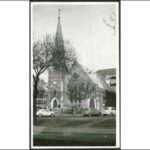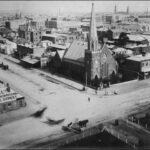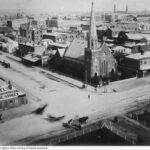Chalmers, or Scots Church, and its evolving parish demonstrate the rich religious history and diversity of Adelaide through its many incarnations. Chalmers Church’s roots can be traced back to 1839, when the first Scottish Presbyterian church opened in the West End. However, Chalmers only opened in 1851, after the Disruption of 1843, when 450 ministers of the state-sponsored Church of Scotland broke away and formed the Free Church of Scotland. Chalmers was named in honour of Reverend Thomas Chalmers, one of the leaders of the Edinburgh revolt.
Fluctuating Religious Landscape
In 1839, a Presbyterian community formed in Adelaide in a church on Gouger Street in the West End. This community moved to Flinders Street in 1865. In 1841, the Church of Scotland, another religious congregation, formed under Reverend Robert Haining in Grenfell Street. In 1859 they moved to Wakefield Street, the eastern half of Adelaide’s horizontal axis.
Upon the Disruption of 1843, in which 450 ministers of the state-sponsored Church of Scotland broke away, the Free Church of Scotland was formed. Scots altered Adelaide’s religious landscape again in 1850 as families invited Reverend John Gardner of the Free Church to the city to start a new parish. Chalmers Church was built in 1851, on this intersection of Pulteney and North Terrace, in honour of Reverend Thomas Chalmers, who led the Disruption in Edinburgh, Scotland.
In 1865 three branches of the Presbyterian faith in South Australia became the Presbyterian Church of South Australia. Upon the 1904 closing of the Church of Scotland’s building on Wakefield Street, in 1929 the Flinders Street Presbyterian church and the Free Church of Scotland joined to become one parish.
In 1977, Scots Church joined the newly formed Uniting Church of Australia.
Architecture and Decoration
The original Chalmers Church opened in 1851 and sat 450; its foundation stone has never been found although its location has been much speculated. 1858 saw the addition of the spire and bell, and in 1864 a two-level schoolroom joined the rear of the church. In 1868 congregants bought a harmonium, or a pump organ, to replace the outdated tuning forks that produced the note for singing. The harmonium (which can still be viewed in the front of the church behind the organist seat) cost £80 and bears a Medal of Honour from the Paris Exhibition of 1865. In 1900, JE Dodd installed a pipe organ (this was replaced by the organ from Flinders Street Church in 1957, an 1882 Fincham and Hobday organ). In 1912, John K Blogg of Melbourne carved the pulpit and the pulpit ornament from a single piece of timber. The pulpit and font both have Celtic motifs.
In 1957, the Hall was built, and some of the building materials and the foundation stone from the previous Flinders Street Church were integrated into it. For example, the windows on the West side of the church came from the Flinders Street building. The Duncan Family donated the organ screen and Iona Cross (so named after a famous cross on Isle of Iona, off the coast of Scotland) in 1958. While Scot Church’s oldest stained glass windows were made in the early 1900s, the north wall of the church features three panels called The Celebration of Creation. These were designed by Lawrence Lee in 1962. On the church’s left side are the Queen’s Colour and the Regimental Colour, two English flags laid in Scots Church in November 22, 1964. These were given to the 27th Battalion Australian Imperial Forces, which were strongly Scottish, for their service in the First World War and Second World War. There are brochures on both subjects available inside the church. In 1990, the Flinders Street organ was rebuilt and enlarged.







Comments